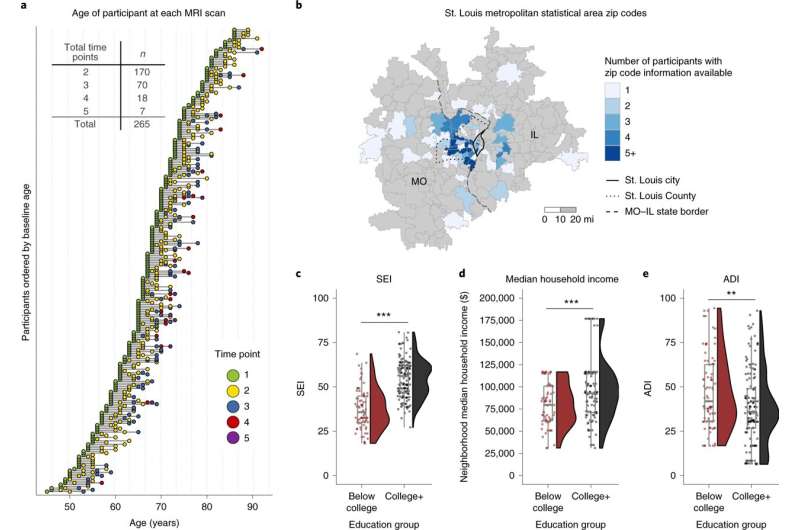Fig. 1: Longitudinal MRI sessions and geographical and SES-related information of participants. a, Every participant had at least two MRI (including resting-state) scan sessions, with 36% of participants having three to five separate sessions over multiple years (maximum range, 9.2 years). b, Number of participants from zip codes within the St. Louis metropolitan statistical area. The border of the city of St. Louis (solid), the county of St. Louis (dotted) and the state border between Missouri (MO) and Illinois (IL; dashed) are also depicted. c, Participants with a college degree have higher socioeconomic index (SEI) (data are available for 86% (n = 228) of participants; t132 = −10.791, P < 0.001, Cohen’s d = 1.552, 95% confidence interval (CI95%) = (−20.122, −13.888)) and d, live in areas (calculated using participants’ zip codes) with higher neighborhood median household income (data available for 65% (n = 171) of participants; t168 = −3.455, P < 0.001, d = −0.520, CI95% (−24,169.742, −6,591.3510); see text for additional comments about outlier observations) and e, lower scores on the area deprivation index (ADI), an index that combines multiple environmental variables to characterize area deprivation (data available for 89% (n = 236) of participants; t170 = 3.197, P = 0.002, d = 0.435, CI95% = (3.417, 14.443)). Each box plot depicts the median (center line) and first and third quartiles (bounds of box), and whiskers extend to 1.5 times the interquartile range. The whisker does not extend to the minimum and maximum of the data, as individual data points are also plotted. Two-sided Welch’s two-sample t-tests were performed for c–e (significance is denoted in c–e with asterisks: **P < 0.01, ***P < 0.001). Credit: DOI: 10.1038/s43587-021-00125-4
A study of large-scale functional brain network organization and educational history, led by researchers at the Center for Vital Longevity (CVL), has identified a new biomarker of Alzheimer's disease. The findings, published online this week in Nature Aging, describe how declines in a measure of brain network organization precede cognitive impairment in older adults. Researchers also found that brain network declines are greater among individuals without a college education, suggesting that there are aspects of an individual's environment that may accelerate brain aging.
"What's exciting about this study is that we've identified a measure of brain function that seems to be sensitive to an individual's past and present environmental exposures during adulthood. That brain network organization is also uniquely related to the prognosis of dementia, which opens up the possibility of incorporating the measure with other markers of Alzheimer's disease risk and pathology in a clinical setting," says Dr. Gagan Wig, director of the Wig Neuroimaging Lab at the CVL and associate professor at The University of Texas at Dallas.
It is well known that older adults with lower education levels are at a greater risk of dementia. But it's unknown why some are more likely to develop dementia than others. The results from this study shed light on an important biomarker of clinical decline by showing that the trajectory of a person's brain network organization varies according to their educational attainment, and is a unique indicator of individual brain health during older age.
"We've been working on this measure of brain network organization for a long time, and we knew it varied in relation to age and cognitive ability, but we were unsure how it changed over time in individuals or whether this would relate to changes in their cognitive health. We now have evidence that changes in brain network organization have a relation to cognitive decline in older age adults," says the study's first author, Dr. Micaela Chan, a postdoctoral scientist in Wig's lab.
The study analyzed existing data that includes adults between the ages of 40 to 80, who received two to five MRI scans, and multiple clinical visits (the latter up to 10 years after the participant's last MRI). Researchers examined the relationship between the participant's education levels and changes in brain network organization over time while also accounting for demographics and various measures of health and pathology.
Brain network changes were evaluated in relation to the trajectories of clinical decline. While there are other known predictors of the development of Alzheimer's disease, such as a person's genetics and pathology, not everyone who has genetic risk or even the presence of pathology exhibits symptoms of dementia. However, the brain network measure changes observed in this study were independent of these other known risk markers, which suggests it contains unique information.
Importantly, the researchers found that the relationship between brain network decline and cognitive impairment was observed regardless of an individual's education, revealing that there are more specific aspects of an individual's environment that modify the brain's network organization.
"We used education levels as an indicator of an individual's environment because it represents things such as access to resources and health behaviors; although it is a coarse measure, it predicts a lot of important life outcomes," says Chan.
Establishing a link between education levels and specific brain changes during older age is not only an important step toward understanding environmental determinants of brain disease but could also lead to the discovery and incorporation of brain network organization as a biomarker of brain health
"We are now working towards identifying the specific aspects of an individual's environment that matter most for maintaining their brain network integrity. At the very least, this study reinforces the idea that education is a modifiable risk factor for older age brain health," says Wig, who is currently recruiting participants for a new study aimed at isolating the specific health, environment, and lifestyle factors that lead to the largest disparities in brain and cognitive function during adulthood.
More information: Micaela Y. Chan et al, Long-term prognosis and educational determinants of brain network decline in older adult individuals, Nature Aging (2021). DOI: 10.1038/s43587-021-00125-4
Journal information: Nature Aging
Provided by University of Texas at Dallas
























